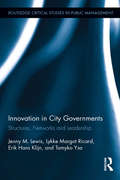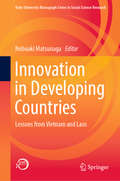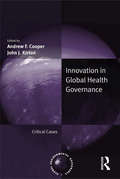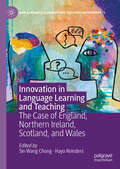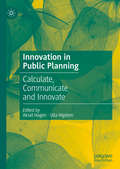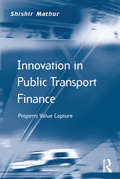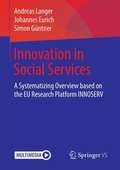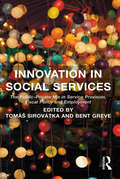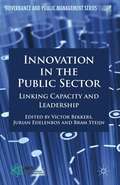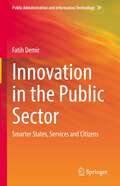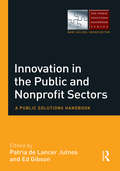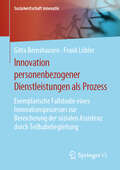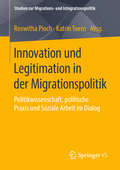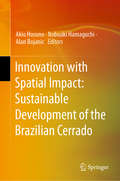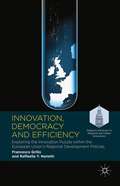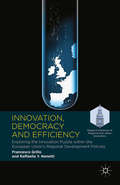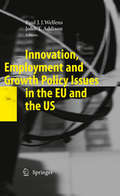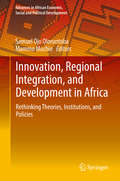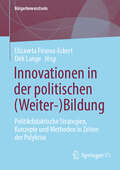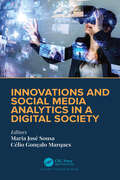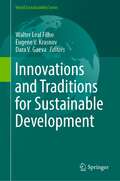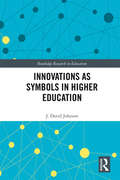- Table View
- List View
Innovation in City Governments: Structures, Networks, and Leadership (Routledge Critical Studies in Public Management)
by Erik Hans Klijn Jenny M. Lewis Lykke Margot Ricard Tamyko Ysa FiguerasInnovation has become an important focus for governments around the world over the last decade, with greater pressure on governments to do more with less, and expanding community expectations. Some are now calling this ‘social innovation’ – innovation that is related to creating new services that have value for stakeholders (such as citizens) in terms of the social and political outcomes they produce. Innovation in City Governments: Structures, Networks, and Leadership establishes an analytical framework of innovation capacity based on three dimensions: Structure - national governance and traditions, the local socioeconomic context, and the municipal structure Networks – interpersonal connections inside and outside the organization Leadership – the qualities and capabilities of senior individuals within the organization. Each of these are analysed using data from a comparative EU research project in Copenhagen, Barcelona and Rotterdam. The book provides major new insights on how structures, networks and leadership in city governments shape the social innovation capacity of cities. It provides ground-breaking analyses of how governance structures and local socio-economic challenges, are related to the innovations introduced by these cities. The volume maps and analyses the social networks of the three cities and examines boundary spanning within and outside of the cities. It also examines what leadership qualities are important for innovation. Innovation in City Governments: Structures, Networks, and Leadership combines an original analytical approach with comparative empirical work, to generate a novel perspective on the social innovation capacity of cities and is critical reading for academics, students and policy makers alike in the fields of Public Management, Public Administration, Local Government, Policy, Innovation and Leadership.
Innovation in Developing Countries: Lessons from Vietnam and Laos (Kobe University Monograph Series in Social Science Research)
by Nobuaki MatsunagaThe main focus of this book is innovation for developing countries: what is the innovation for, what are the current conditions of the innovation, and how to effectively innovate in developing economies. It contains the latest insights and analyses of innovation based on intensive interviews as well as primary and secondary data of manufacturing firms in developing countries, Vietnam and Laos in particular. Innovation requires something new. Integration of deep understanding of innovation and econometric analyses are a “new combination” in this book, which contrasts with other, similar books in the field. This new approach may benefit policy makers as well as scholars and firms in poor countries. The main points of the book are summarized as follows: First, for most poor countries “learning innovation” is considered the key to economic growth rather than “leading-edge innovation”, which is a more popular theme in similar books on innovation. Second, an overwhelming majority of innovations currently used in poor countries are developed in advanced countries, so technology transfer and learning from the latter are a fundamental source of innovation in the former. Third, a surprisingly high rate of firms (around 50%) reported that they introduced new or significantly improved products or processes in poor countries, and this high innovation rate is a great benefit to be enhanced by government policies. Fourth, the common factors driving innovation of manufacturing firms in Vietnam and Laos are (1) human capital, (2) social capital, and (3) innovation in the past. Fifth, the impact of innovation on firm performance is found to be mixed in these countries. Sixth, so far almost all studies on innovation have focused on product or process innovation, but additional light is shed here on organizational innovation.
Innovation in Global Health Governance: Critical Cases (Global Environmental Governance)
by Andrew F. CooperAnalyzing twenty-first century innovations in global health governance, this volume addresses questions of pandemics, essential medicines and disease eradication through detailed case studies of critical and rapidly spreading infectious diseases such as HIV/AIDS and SARS and 'lifestyle' illnesses such as tobacco-related illnesses, all of which are at the centre of the current global health challenge. Given its contemporary focus and wide range of world leading experts, this study is highly suitable for courses on global governance generally and global public health specifically across political science, economics, law, medicine, nursing and related fields. Scholars, practitioners and clinicians seeking a context for their front line health care provision will find this volume invaluable.
Innovation in Language Learning and Teaching: The Case of England, Northern Ireland, Scotland, and Wales (New Language Learning and Teaching Environments)
by Hayo Reinders Sin Wang ChongThis book investigates the ways in which new developments in areas of language teaching practice, such as policy-making, planning, methodology and the use of educational technology are locally adopted, adapted, and initiated and implemented in the four nations of the United Kingdom: England, Northern Ireland, Scotland, and Wales. By looking at the drivers, stakeholders, obstacles, and affordances in particular regional contexts, it is possible to gain a deeper insight into the ways in which change processes occur. This will help anyone involved in language development, from curriculum reform to materials development, and from programme evaluation to the setting of assessment standards. The chapters in this book cover all aspects of language education in England, Northern Ireland, Scotland, and Wales, from the primary to tertiary levels in both private and public settings, as well as innovations at local, regional and national levels. The book will be of particular interest to those involved in managing change in language education that attempts to mediate between global trends and local needs.
Innovation in Public Planning: Calculate, Communicate and Innovate
by Aksel Hagen Ulla HigdemThis book contributes to the discourse on planning theory by accentuating the perspective of public innovation. Extending planning theory's traditional two major perspectives - 'Communicate' and 'Calculate' - the book argues that contemporary planning theory should incorporate 'Innovate' as a third perspective. It highlights the multitude of new perspectives that innovative planning can bring to bear on planning theory, as well as showing how the interplay between the three perspectives - 'Communicate', 'Calculate' and 'Innovate' - can help to address vital issues in contemporary societal development.
Innovation in Public Transport Finance: Property Value Capture (Transport and Mobility)
by Shishir MathurWith all levels of governments currently, and for the foreseeable future, under significant fiscal stress, any new transit funding mechanism is to be welcomed. Value capture (VC) is one such mechanism, which involves the identification and capture of a public infrastructure-led increase in property value. This book reviews four major VC mechanisms: joint development projects; special assessment districts; impact fees; and tax increment financing; all of which are used to fund transit in the United States. Through the study of prominent examples of these VC mechanisms from across the US, this book evaluates their performance focusing on aspects such as equity, revenue-generating potential, stakeholder support, and the legal and policy environment. It also conducts a comparative assessment of VC mechanisms to help policy makers and practitioners to choose one, or a combination of VC mechanisms. Although the book focuses on the US, the use of the VC mechanisms and the urgent need for additional revenue to fund public transportation are world-wide concerns. Therefore, an overview of the VC mechanisms in use internationally is also provided.
Innovation in Social Services: A Systematizing Overview based on the EU Research Platform INNOSERV
by Andreas Langer Johannes Eurich Simon GüntnerAcross Europe, there is an intense search for new and sustainable approaches to providing welfare. Demographic change, new social risks and other factors call for new ideas to maintain and enhance the performance and quality of social services and to enable the participation of all citizens in an inclusive society.Against this background, and based on the findings of the EU research platform INNOSERV and empirically obtained research results from text and video material, this book provides insights into current approaches and practices to improve and transform social services.
Innovation in Social Services: The Public-Private Mix in Service Provision, Fiscal Policy and Employment
by Bent Greve Tomáš SirovátkaEU member states have seen high levels of unemployment in recent years especially amongst young people. At the same time the fiscal crisis of welfare states has made it difficult for them to invest in new jobs and new economic growth. The EU, at least since the enactment of the Amsterdam treaty, has had a focus on how to support member states’ development of an employment policy which aims for higher levels of participation, lower levels of unemployment and more gender equal approaches. Through exploring patterns in the recent development of financing and governance of social services and developments of social services and employment in the Czech Republic, Denmark, Germany and the UK, this volume provides readers with new knowledge and evidence of the options regarding social innovation in social services. Furthermore, it provides a comparative European perspective on how the interplay between a public and private mix of social service on the one hand might help in creating jobs, and, on the other, be a way of coping with the needs and expectations of higher level of services in the core areas of the welfare state.
Innovation in the Public Sector
by Victor Bekkers Jurian Edelenbos Bram SteijnAddresses issues relevant to an understanding of the innovation journeys on which public organizations have embarked. If public innovation is defined as a necessary condition for establishing meaningful interactions between the government and society what are the relevant issues that may explain successful processes and forms of public innovation?
Innovation in the Public Sector: Smarter States, Services and Citizens (Public Administration and Information Technology #39)
by Fatih DemirThe book discusses smart governments and innovation in the public sector. In hopes of arriving at a clear definition of innovation in the field of public administration, the volume provides a wide survey of global policies and practices, especially those aimed at reducing bureaucracy and using information-communication technologies in public service delivery. Chapters look at current applications across countries and multiple levels of government, from public innovation labs in the UK to AI in South Korea. Providing concrete examples of innovation culture at work in public institutions, this volume will be of use to researchers and students studying new public management, public service delivery, and innovation as well as practitioners and professionals working in various public agencies.
Innovation in the Public and Nonprofit Sectors: A Public Solutions Handbook (The Public Solutions Handbook Series)
by Patria De Lancer Julnes Ed GibsonIn the organizational context, the word "innovation" is often associated with private sector organizations, which are often perceived as more agile, adaptable, and able to withstand change than government agencies and nonprofit organizations. But the reality is that, while they may struggle, public and nonprofit organizations do innovate. These organizations must find ways to use shrinking resources effectively, improve their performance, and achieve desirable societal outcomes. Innovation in the Public Sector provides alternative frameworks for defining, categorizing, and studying innovation in government and in the nonprofit sector. Through a diverse collection of international case studies, this book broadens the discussion of innovation in public and nonprofit organizations, demonstrating the hurdles organizations face and examining the technological advances and managerial ingenuity innovators use to achieve their goals, both within and beyond the boundaries of the innovating organization. The chapters shed light on key issues including: how to conceptualize innovation; how organizations decide between competing good ideas; how to implement innovation; how to contend with challenges to innovation; how to judge success in innovation This book provides current and future public managers with the understanding and skills required to manage change and innovation, and is essential reading for all those studying public management, public administration, and public policy.
Innovation in the U.S. Service Sector (Routledge Studies in Innovation, Organizations and Technology)
by Albert N. Link Michael P. Gallaher Jeffrey E. PetrusaUsing a cutting-edge structure, where a current description of the service sector and up-to-date case studies are compared and contrasted with innovative activity in manufacturing, this book contributes towards a better theoretical understanding of innovation in the U.S. service sector. The U.S. service sector is the largest sector in the U.S. economy and accounts for an increasingly significant share of U.S. gross domestic product, currently 68 percent. Both in the United States, as well as in other industrialized nations, the service sector is a dynamic component of economic activity and growth. As pervasive and economically important as the service sector is, innovative activity in service-sector firms remains somewhat of an enigma; it is not well understood and not well defined because it differs dramatically from the traditional model of innovation in manufacturing. Innovation in the U.S. Service Sector fills this void, placing emphasis on the United States, but with global relevance. It is essential reading for all students of business and management, economics and political science.
Innovation personenbezogener Dienstleistungen als Prozess: Exemplarische Fallstudie eines Innovationsprozesses zur Bereicherung der sozialen Assistenz durch Teilhabebegleitung (Sozialwirtschaft innovativ)
by Gitta Bernshausen Frank LöblerIn diesem Buch wird beschrieben, wie Dienstleistungsprozesse in Sozialunternehmen verändert werden können, um auch weiterhin als Leistungserbringer im Wettbewerb bestehen zu können. Prozesse der Entwicklung und Umsetzung von Innovationen sind erfolgreich, wenn personelle und finanzielle Ressourcen eingesetzt, fachliche Expertise und die Kompetenz zum Projektdesign, zur Projektsteuerung und -evaluation sowie zur Personal- und Organisationsentwicklung eingebracht werden. Welche Voraussetzungen für das Erkennen der Notwendigkeit von Innovationen sowie für das Gestalten eines erfolgreichen Innovationsprozesses gegeben sein müssen – und welche Instrumente dabei eingesetzt werden -, wird exemplarisch anhand einer Fallstudie gezeigt.Der InhaltWandel der Sozialwirtschaft: Auswirkungen auf die Unternehmen und die Dienstleistungen • Die Verwirklichung sozialer Inklusion erfordert Innovation • Qualität des Lebens: Ein passendes Konzept für die Gestaltung sozialer Dienstleistungen • Den Innovationsprozess erfolgreich gestalten • Der Innovationsprozess aus der Perspektive von Beteiligten • Individuelle Qualität des Lebens messen mit der Personal Outcomes Scale • Der Innovationsprozess von sozialen personenbezogenen Dienstleistungen. Zwischenbilanz eines ProjektesDie AutorenGitta Bernshausen ist Diplom-Sozialarbeiterin und ist im Vorstand des Sozialwerks St. Georg e.V. in Gelsenkirchen für den Bereich Human Resources, Qualität, Sozialpolitik sowie Forschung und Entwicklung zuständig. Frank Löbler ist Diplom-Sozialwissenschaftler und leitet das Ressort Qualität beim Sozialwerk St. Georg e.V. in Gelsenkirchen. Er ist in dieser Funktion für das Qualitätsmanagement und die Personal Outcomes Scale zuständig.
Innovation und Legitimation in der Migrationspolitik: Politikwissenschaft, politische Praxis und Soziale Arbeit im Dialog (Studien zur Migrations- und Integrationspolitik)
by Roswitha Pioch Katrin ToensWie kann die Politik Innovationen vorantreiben und zugleich Legitimation und demokratische Unterstützungsbereitschaft in der Bevölkerung erzeugen? Der Sammelband zeigt im Feld der Migrations- und Flüchtlingspolitik, wie im Regierungshandeln Innovation und Legitimation auf Bundesebene, in der Europäischen Union, in den Bundesländern und Kommunen zusammenhängen. Dazu dient der internationale Vergleich mit Kanada und anderen Einwanderungsländern.
Innovation with Spatial Impact: Sustainable Development Of The Brazilian Cerrado
by Akio Hosono Nobuaki Hamaguchi Alan BojanicThis book is unique and original, constituting a pioneering study in the use of spatial economics and related analytical approaches to Brazil’s Cerrado agricultural development and the formation of agro-industrial value chains. This methodology is appropriate because Cerrado agriculture has been developed from scratch in a vast, previously barren area (204.7 million ha.) in which a spatial transformation has taken place. Until 40 years ago, this region, with its huge expanse of tropical savanna was believed to be unsuited to agriculture. Now, however, it has been transformed into an immense breadbasket, contributing to the mitigation of global food shortages. It also has contributed to the inland development of Brazil, promoting urbanization with a higher living standard and modern production techniques. This book identifies critical factors that enabled the transformation of the Cerrado. To understand the process of agricultural development and the formation of agro-industrial value chains, spatial economics and related approaches are essential because the process involves spatial interactions such as transportation, supply chains, knowledge spillovers, environmental constraints, migration, and urbanization. The book demonstrates that the initial development of Cerrado agriculture was a genuine spatial transformation with contributions from pioneering producers, agribusinesses, and central and local governments, as well as through international cooperation. It also discusses agriculture and agro-industrial value chains focusing on inclusive and sustainable development, a major concern of the international community particularly in terms of the Sustainable Development Goals.
Innovation, Democracy and Efficiency: Exploring the Innovation Puzzle within the European Union's Regional Development Policies (Palgrave Advances In Regional And Urban Economics)
by Raffaella Y. Nanetti Francesco GrilloInnovation, Democracy and Efficiency.
Innovation, Democracy and Efficiency: Exploring the Innovation Puzzle within the European Union’s Regional Development Policies (Palgrave Advances in Regional and Urban Economics)
by Raffaella Y. Nanetti Francesco GrilloEndogenous growth theory has significantly impacted most of the developing and developed countries, shifting priorities of industrial policies towards innovation. In line with this trend, the European Union significantly increased its budgetary allocation for R&D. However, statistical data show a weak correlation between R&D expenditure and the acceleration of economic growth. Regional innovation policies display divergent returns according to different institutional conditions and policy choices.Grillo and Nanetti attempt to understand the reasons that lie behind differences in performance. Their results show that better performing innovation strategies require the following factors: clear choices of locally congruent smart specialization; strong capacity of public investment to stimulate additional private investment; clear distribution of responsibilities for decision-making and independence of policy implementation from political interference; and problem solving partnerships amongst innovators, universities, and governments that pre-exist the programmes. These factors point to a relationship between democracy (defined as openness of policy-making) and innovation (as technology-enabled growth) which is explored throughout this book.
Innovation, Dual Use, and Security: Managing the Risks of Emerging Biological and Chemical Technologies
by Jonathan B. Tucker Richard DanzigRecent advances in disciplines such as biotechnology, nanotechnology, and neuropharmacology entail a "dual-use dilemma" because they promise benefits for human health and welfare yet pose the risk of misuse for hostile purposes. The emerging field of synthetic genomics, for example, can produce custom DNA molecules for life-saving drugs but also makes possible the creation of deadly viral agents for biological warfare or terrorism. The challenge for policymakers is to prevent the misuse of these new technologies without forgoing their benefits . Innovation, Dual Use, and Security offers a systematic approach for managing the dual-use dilemma. The book presents a "decision framework" for assessing the security risks of emerging technologies and fashioning governance strategies to manage those risks. This framework is applied to fourteen contemporary case studies, including synthetic genomics, DNA shuffling and directed evolution, combinatorial chemistry, protein engineering, immunological modulation, and aerosol vaccines. The book also draws useful lessons from two historical cases: the development of the V-series nerve agents in Britain and the use and misuse of LSD by the U. S. Army and the CIA. Innovation, Dual Use, and Security offers a comprehensive, multifaceted introduction to the challenges of governing dual-use technologies in an era of rapid innovation. The book will be of interest to government officials and other practitioners as well as to students and scholars in security studies, science and technology studies, biology, and chemistry.
Innovation, Dual Use, and Security: Managing the Risks of Emerging Biological and Chemical Technologies (The\mit Press Ser.)
by edited by Jonathan B. TuckerA framework for assessing the security risks of emerging dual-use technologies and devising tailored governance strategies is proposed and applied to contemporary case studies.Recent advances in disciplines such as biotechnology, nanotechnology, and neuropharmacology entail a “dual-use dilemma” because they promise benefits for human health and welfare yet pose the risk of misuse for hostile purposes. The emerging field of synthetic genomics, for example, can produce custom DNA molecules for life-saving drugs but also makes possible the creation of deadly viral agents for biological warfare or terrorism. The challenge for policymakers is to prevent the misuse of these new technologies without forgoing their benefits. Innovation, Dual Use, and Security offers a systematic approach for managing the dual-use dilemma.The book presents a “decision framework” for assessing the security risks of emerging technologies and fashioning governance strategies to manage those risks. This framework is applied to fourteen contemporary case studies, including synthetic genomics, DNA shuffling and directed evolution, combinatorial chemistry, protein engineering, immunological modulation, and aerosol vaccines. The book also draws useful lessons from two historical cases: the development of the V-series nerve agents in Britain and the use and misuse of LSD by the U.S. Army and the CIA.Innovation, Dual Use, and Security offers a comprehensive, multifaceted introduction to the challenges of governing dual-use technologies in an era of rapid innovation. The book will be of interest to government officials and other practitioners as well as to students and scholars in security studies, science and technology studies, biology, and chemistry.
Innovation, Employment and Growth Policy Issues in the EU and the US
by John T. Addison Paul J.J. WelfensThe EU and the U.S. confront distinct factor market dynamics and common policy challenges. Labor market developments and long-term changes in capital markets and capital flows represent key problems in aging societies. The analyses presented here compare the European and U.S. patterns in this regard. Moreover, Schumpeterian innovation dynamics as well as energy policy issues receive attention. Considerable differences in innovation dynamics are reported across countries. The book charts the role of different innovation systems and knowledge societies and highlights different policy approaches. Another focus is upon structural changes and innovation in open economies. Finally, medium and long-term options for transatlantic cooperation are evaluated against the backdrop of the Lisbon agenda.
Innovation, Regional Integration, and Development in Africa: Rethinking Theories, Institutions, And Policies (Advances in African Economic, Social and Political Development)
by Samuel Ojo Oloruntoba Mammo MuchieThis edited volume discusses the role of innovation and regional integration in economic development in Africa. Over the past five decades, post-colonial African countries have struggled to break loose from the trap of poverty and underdevelopment through the adoption of various development strategies at regional, national, and continental levels. However, the results of both national and regional efforts at advancing development on the continent have been mixed. Although the importance of agglomeration and fusion of institutions have long been recognized as possible path to achieving economic development in Africa, the approach to regionalism has been unduly focused on market integration, while neglecting other dimensions such as social policy, mobility of labor, educational policy, biotechnology, regional legislation, manufacturing, innovation, and science and technology. This volume investigates the link between innovation, regional integration, and development in Africa, arguing that the immediate and long term development of Africa lies not just in the structural transformation of its economies but in the advancement of scientific and innovation capacities. The book is divided into four parts. Part I addresses the theoretical and conceptual underpinnings of innovation and regional integration in Africa. Part II presents case studies which examine how regional economic institutions are fostering innovation in Africa. Part III of the book deals with sectoral issues on innovation and integrated development in Africa. Part IV sets the future research on innovation, regional integration, and development in Africa. Combining theoretical analysis and a comparative, interdisciplinary approach, this volume is appropriate for researchers and students interested in economic development, political economy, African studies, international relations, agricultural science, and geography, as well as policymakers in regional economic communities and the African Union.
Innovationen in der politischen: Politikdidaktische Strategien, Konzepte und Methoden in Zeiten der Polykrise (Bürgerbewusstsein)
by Nele VerwiebeDie Gesellschaft befindet sich derzeit in einem Zustand, der von zahlreichen und akuten Krisen geprägt ist. Der Band erörtert verschiedene gesellschaftlich relevante Krisen und stellt Projekte vor, die sich diesen Herausforderungen stellen und pädagogische Umgangsweisen entwickeln. Darüber hinaus werden innovative Methoden für Lehr- und Lernkonzepte mit einem interdisziplinären und vor allem europäischen Ansatz zusammengeführt. Internationale Perspektiven auf (Weiter-)Bildung, die im Rahmen europäischer Zusammenarbeit entstanden sind, werden vorgestellt und bieten einen globalen Blick auf verschiedene Themenfelder. Alle Beiträge ziehen Schlussfolgerungen und entwickeln Ideen zur Weiterentwicklung der politischen (Weiter-)Bildung, die für Didaktiker*innen unterschiedlichster Bereiche – darunter Lehrkräfte, Praktiker*innen der politischen Bildung sowohl aus dem schulischen als auch außerschulischen Bereich sowie Dozierende der Erwachsenenbildung – von Bedeutung sind.
Innovations and Social Media Analytics in a Digital Society
by Maria José Sousa and Célio Gonçalo MarquesRecent advances in digitization are transforming healthcare, education, tourism, information technology, and some other sectors. Social media analytics are tools that can be used to measure innovation and the relation of the companies with the citizens. This book comprises state-ofthe-art social media analytics, and advanced innovation policies in the digitization of society. The number of applications that can be used to create and analyze social media analytics generates large amounts of data called big data, including measures of the use of the technologies to develop or to use new services to improve the quality of life of the citizens. Digitization has applications in fields from remote monitoring to smart sensors and other devices. Integration generates data that need to be analyzed and visualized in an easy and clear way, that will be some of the proposals of the researchers present in this book. This volume offers valuable insights to researchers on how to design innovative digital analytics systems and how to improve information delivery remotely.
Innovations and Traditions for Sustainable Development (World Sustainability Series)
by Walter Leal Filho Eugene V. Krasnov Dara V. GaevaThis book highlights the vital necessity for combining sustainable development processes from different areas, with applications in areas such as science, education and production sectors. These sectors have previously been separated by linguistic and technological barriers. Breaking down these barriers will allow an interdisciplinary and transdisciplinary flow of information, leading to greater efficiency, and towards a more real resilient and sustainable economy development. This book fills in the gap in respect of publications addressing aspects of innovation and sustainable development and focuses on a range of areas, such as I. Gradual transition to innovative development; II. Continuity of technology in education, science and industry; III. Convergency directions, interdisciplinary relations in scientific research; IV. Digital technologies for sustainable development; V. Global trends and regional aspects of innovation and traditions in environmental management; VI. International legal regulations and environmental and economic relations among business communities. The publication fosters the global efforts towards taking better advantage of the many opportunities which innovation in specific areas may offer.
Innovations as Symbols in Higher Education (Routledge Research in Education #17)
by J. David JohnsonExamining the role of symbolic innovations in higher education institutions, this book distinguishes between the real, material changes universities undergo and the ways universities present them and symbolic changes to outside and internal stakeholders. By defining symbolic innovations and their general role in organizations, this book provides a thorough view of innovations in university contexts and the underlying factors that motivate and generate them. This volume addresses ethical concerns about the impact of symbolic innovations and how they relate to traditional and current views of academic leadership.
